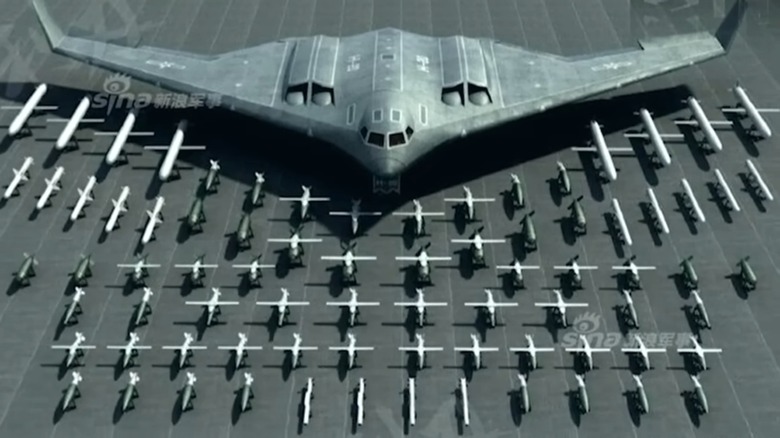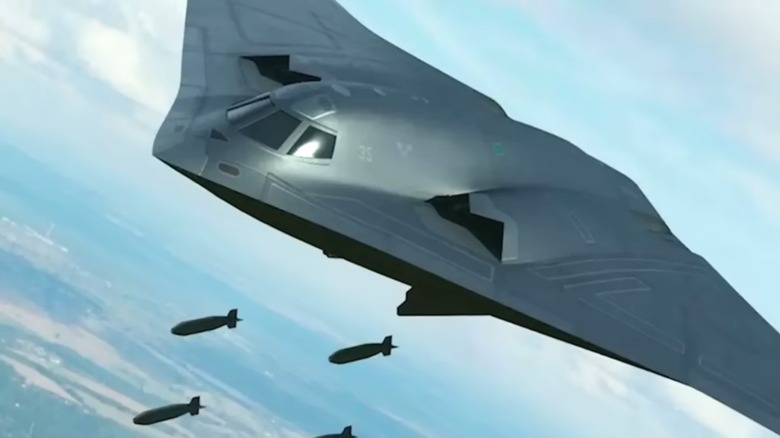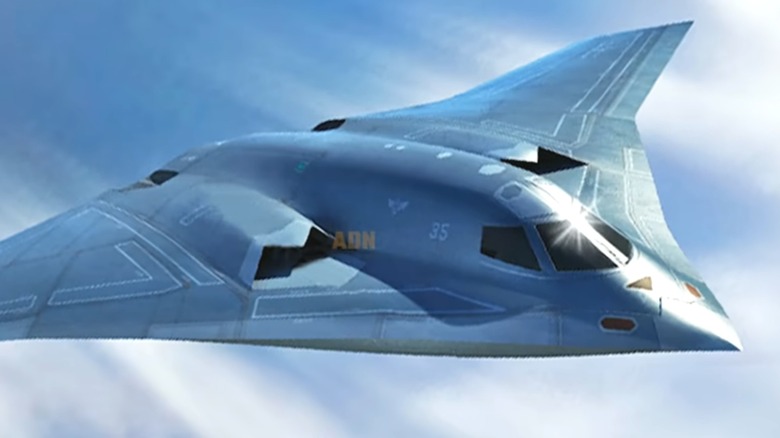Here's Why China's New H-20 Strategic Stealth Bomber Doesn't Concern The West
Decades ago, the U.S. military built its nuclear arms capabilities into a triad consisting of long-range intercontinental ballistic missiles (ICBM), submarine-launched ballistic missiles (SLBM), and strategic bombers outfitted with nuclear ordnance. America's nuclear triad ensures the nation's offensive capabilities are widespread, but the People's Republic of China (PRC) hasn't followed suit. It began developing nuclear weapons in the 1960s, but one thing it never developed was a long-range strategic bomber.
This was largely due to a lack of need, but the country is progressing forward and announced the development of a dedicated strategic bomber in 2016. The Chinese Xi'an H-20 is a flying wing design that looks very similar to America's B-2 bomber. Development of the H-20 continues, and according to state-sponsored programming, it likely took its maiden flight in July 2022. By March of 2024, Wang Wei, the vice commander of the People's Liberation Army Air Force, announced its completion and that entry into active service was imminent.
China's development of the H-20 shows a shift in nuclear arms strategy, leading nuclear security experts to voice concern over the project. Not only does the H-20 bear a striking resemblance to an American aircraft (the B-2), and China is known to steal tech, but the introduction of an intercontinental strategic bomber indicates the potential threat. China's weapons and possibly its strategic nuclear ambitions mirror the U.S. military's, but the H-20 may not compare to America's strategic bombers.
What is known about the H-20
While the PRC isn't in the habit of disclosing the technical details of its weapons platforms, some information has come out regarding the H-20's design. Superficially, it looks similar to the B-2 Spirit and B-21 Raider developed by Northrop Grumman in 1997 and 2023, respectively. The design is somewhat different, but it's easy to speculate that the H-20 was inspired by the American systems as a launchpad in its design. It's a subsonic flying wing design, measuring an estimated 100 feet in length.
Based on its apparent size, the H-20 will likely be able to take off with a payload of 60 tons. Additionally, the aircraft's range is anywhere between 2,000 miles in some outlets to 5,280 miles, based on the Pentagon's annual report to Congress in 2021. Like American strategic bombers, the H-20 will likely be able to carry both conventional and nuclear weapons, including missiles and bombs.
The H-20's top speed is unknown, though it will be subsonic, meaning it won't be able to fly as fast as Mach 1 (761 mph). Additionally, the H-20 bears a similar design to American stealth aircraft, suggesting it will implement similar technology. China developed stealth technology for its Chengdu J-20 fighter, so the tech is available. That said, stealth technology for a fighter and a bomber of significantly different sizes and shapes isn't the same thing, so the H-20's stealth capabilities remain an unknown factor.
Should the West worry about the H-20?
On the surface, the H-20 indicates a shift in China's self-defensive nuclear strategy, but it's not necessarily a danger. While the H-20 could theoretically strike targets in the continental United States, it's hardly the only weapon the PRC has in its arsenal with that capability. The nation already has ICBMs and nuclear warheads, so adding a strategic bomber capability brings the PRC to two-thirds of what America's nuclear triad is, though with far fewer options. Still, the H-20 poses a threat, but American officials at the Pentagon aren't overly concerned.
A Department of Defense intelligence official told reporters in April 2024 what they thought of the aircraft. "The thing with the H-20 is when you actually look at the system design, it's probably nowhere near as good as U.S. LO [low observable] platforms, particularly more advanced ones that we have coming down; they've run into a lot of engineering design challenges, in terms of how do you actually make that system capability function in a similar way to, like, a B-2 or a B-21, " an anonymous Defense Department official said, according to Breaking Defense.
The official further explained that the aircraft wasn't a major issue, and China's unveiling of the H-20 was little more than saber-rattling. Additionally, despite China's announcement concerning the H-20, it probably won't be ready until the end of the decade. Conversely, the U.S. will introduce the new B-21 Raider by the mid-2020s, so there's little to worry about regarding China's new toy.


